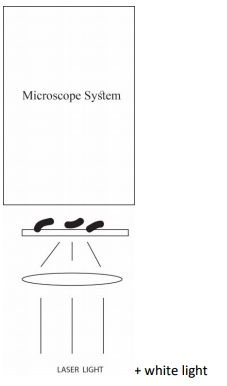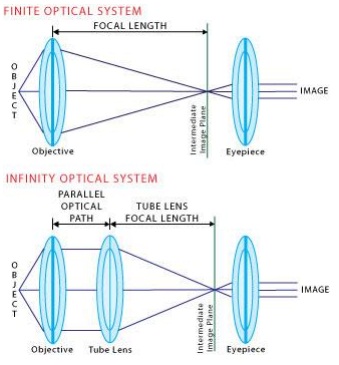Assignment:
Time for completion:
Part 1:
In this project, you will build a useful system for microcopy: The goal is to measure the fluorescence (light emission) from molecules on a substrate. The molecules are excited from the backside of the stage, and light is collected from and sent to a Camera (instead of eye). You will design the system.

1- Design the microscope so that individual molecules, that are 1 micrometers in size, are clearly imaged on the camera. Clearly imaged means that the molecule will span at least 100 pixels on the camera. Assume the camera is 5 Megapixels and has a 1 cm x 1 cm sensor size. Identify the different optics (objective, eye piece, etc...), lenses and focal lengths, distances etc...
2- Assume your lenses are all 2 inches in diameter. You want to improve the aberrations by placing an aperture stop to limit the use of the objective to 30% of its size around its center. Assuming the molecules scatter the imaging light over 360o (equally over all angles), what percentage of the light is gathered by the microcope?
3- Write an Analytical ray tracing program to trace the rays through the microscope all the way to the camera. Follow a ray of your choice through the system.
Part 2:
We will modify the microscope slightly by moving the object to the focus of the objective and adding a 2nd lens, called the tube lens. The space between the objective and the tube lens (shown in the image above labelled as "Parallel optical path") can be referred to as Infinity Space and provides a path of parallel light where optical components can be placed without the introduction of spherical aberration or modification of the objective's working distance.
The magnification produced by an infinity-corrected objective is calculated by dividing the reference focal length (tube length) by the focal length of the objective.

The goal of this part is to use the space between the objective and lens tube to place an optical element that allows us to capture the fluorescence from the molecule (after it's excited by laser light) and send it to an interferometer while simultaneously being able to image the molecule that is fluorescing. Assume that the laser light is capable of exciting one molecule only.
4- What optical element will allow you to keep the imaging capability of the microscope, while simultaneously sending most of the fluorescence (say 90%) out of the microscope? Write it's appropriate S-matrix. You will place that element in the "parallel optical path".
Part 3:
You want to measure the coherence time of the molecule's fluorescence. In class, we have studied two interferometers that allow us to do that: One through measuring the coherence time/length, and the other by measuring the spectral width. One is the Mach-Zehnder (MZI) , and the other is the Fabry-Perot.
Assume you expect the emission is in the form of a 1 ns FWHM Lorentzian pulse and you want to measure it exactly.
5- For the MZI system, you want to build an interferometer with one tunable (in length) arm. The goal is to be able to use the scanning arm to measure the coherence length. Draw the system, identify its individual components and the mechanism you would employ to measure the coherence length. Provide examples.
6- For the Fabry-Perot system, design the mirrors and length to provide a linewidth << the expected spectral width of the fluorescence. Show that by varying the length of the Fabry-Perot, the resonance can scan through the fluorescence hence reconstructing it by placing the output on a detector.
7- How should the result of 5 and 6 relate to each other?